Statistics on migration to Europe
Statistics on migration to Europe

The share of foreign-born population in the EU is lower than in most high-income countries.
Foreign-born residents per country
Source: Eurostat, UNDESA, data from 2020
Note: non-EU born in case of the EU (i.e. those born in another Member State are not included); if intra-EU mobile persons were included, the share would be 12.4%
Reasons to stay in Europe
All valid residence permits at the end of 2021 by reason
Source: Eurostat; without Denmark; end of 2020 data in case of Croatia, Finland, Hungary and Ireland; “other” includes permits issued for the reason of residence only, permits issued to victims of trafficking of human beings and unaccompanied minors, as well as permits issued for all other reasons for which residence permits may be issued and which are not covered by the other categories
Among the non-EU citizens residing in the EU with a valid residence permit at the end of 2021, most were holding permits issued for family or work reasons.
Employment of immigrants
In 2021, 8.84 million non-EU citizens were employed in the EU labour market, out of 189.7 million persons aged from 20 to 64, corresponding to 4.7% of the total.
The employment rate in the EU in the working-age population is higher for EU citizens (74%), than for non-EU citizens (59.1%) in 2021.
Fact to consider: Many non-EU citizens are “essential workers”.
Over-represented sectors
In 2021, non-EU citizens were over-represented in some specific economic sectors such as:
| Sector | Overall employment of non-EU citizens | Overall employment of EU citizens |
|---|---|---|
| Accommodation and food service activities | 10.2% | 3.7% |
| Administrative and support service activities | 7.7% | 3.8% |
| Domestic work | 6.7% | 0.7% |
| Construction | 9.2% | 6.6% |
Over-representation by occupation
In terms of occupations, non-EU citizens were over-represented among:
Under-represented sectors
Non-EU citizens were under-represented in other economic sectors, including:
| Sector | Overall employment of non-EU citizens | Overall employment of EU citizens |
|---|---|---|
| Public administration and defence, compulsory social security | 1.3% | 7.5% |
| Education | 3.8% | 7.7% |
| Human health and social work activities | 8.3% | 11.3% |
| Professional, scientific and technical activities | 3.5% | 5.9% |
Under-representation by occupation
On the other hand, non-EU citizens were under-represented among:
| Occupational group | Overall employment of non-EU citizens | Overall employment of EU citizens |
|---|---|---|
| Teaching professionals | 2.4% | 5.6% |
| Business and administration associate professionals | 2.7% | 6.9% |
| General and keyboard clerks | 1.6% | 4.4% |
| Science and engineering associate professionals | 1.7% | 3.6% |
| Business and administration professionals | 2.2% | 4.4% |
| Health professionals | 1.4% | 3.1% |
Refugees in Europe
Refugees from Ukraine
Since Russia’s military aggression in Ukraine in February 2022, Europe has received the largest number of people fleeing war since World War II. For up-to-date details of the efforts to welcome people fleeing the war in Ukraine and to provide temporary protection, see the dedicated page Migration management: Welcoming refugees from Ukraine.
Overall situation at end of 2021
Based on data from UNHCR, at the end of 2021, all around the world there were:
Fact to consider: at the end of 2021, less than 10% of all the world’s refugees and only a fraction of internally displaced persons were living in the EU.
The share of refugees in the EU was 0.6% compared to its total population.
Number of refugees compared to total population
Several countries around the world host a large refugee population:
Source: UNHCR
Note: The graph shows the ten countries hosting the most refugees and the EU
Fact to consider: The majority of refugees from Africa and Asia do not come to Europe, but rather move to neighbouring countries.
Migration to and from the EU
Migration numbers in 2020
Fact to consider: Without migration, the European population would have shrunk by half a million in 2019, given that 4.2 million children were born and 4.7 million people died in the EU. In 2020, EU population shrunk by about 100 thousand people (from 447.3 million on 1 January 2020 to 447.2 million on 1 January 2021), due to a combination of less births, more deaths and less net migration.
In 2021, 2.95 million first residence permits were issued in the EU, compared to 2.3 million in 2020, reaching almost similar numbers as before the start of the COVID-19 pandemic (3.0 million in 2019). The decrease was driven by the travel restrictions introduced to curb the spread of the COVID-19 virus. The pandemic had a particularly strong negative impact on education-related permits and, as a result, their share decreased from 13% in 2019 to 11% in 2020. In 2021, there was a particularly large increase in case of work-related permits, the share of which grew from 39% in 2020 to 45% in 2021. In 2021, first permits were issued for the following reasons:
Source: Eurostat; “other” includes permits issued for the reason of residence only, permits issued to victims of trafficking of human beings and unaccompanied minors, as well as permits issued for all other reasons for which residence permits may be issued and which are not covered by the other categories
55 Study Abroad Statistics: Facts and Figures [2022 Updated]
![55 Study Abroad Statistics: Facts and Figures [2022 Updated]](https://ivypanda.com/blog/wp-content/uploads/2020/11/travel-necessities-704x372.jpg)
Are you thinking about studying abroad, but are not sure if it’s worth your time? Or are you ready to participate in a study abroad program, but need some extra talking points to convince your parents that you’ve made a smart decision?
The number of American students who go abroad has more than tripled in the past two decades (304,467 students in the 2013-2014 academic year), and this increase is likely to continue. International education is on the rise, and for good reason: research has shown that students who study abroad have better career prospects and are more socially aware. Read on to discover more study abroad statistics, facts, and figures that reflect the latest trends in international education.
✈ Benefits of studying abroad
For many years, the benefits of studying abroad have been described in words like these: “It will completely change your life!” and “You will come back a new person.” But the exact long-term benefits were unknown. Now, though, the positive impact of study abroad experiences can be proven with study abroad statistics.
The Institute for International Education of Students (IES) conducted a survey to explore the long-term impact of study abroad on the personal, professional, and academic lives of students. Here are some interesting findings:
95% of the students who were surveyed admitted that studying abroad served as a catalyst for increased maturity, 96% reported increased self-confidence, and 95% said it had a lasting impact on their worldview.
More than 50% of the respondents are still in contact with U.S. friends they met when studying abroad. and often see them during summer traveling.
One of the goals of study abroad programs is to train future global leaders who will respect other cultures and political and economic systems and care about the world’s welfare. The survey reveals that study abroad is succeeding in this mission:
98% of the students stated that study abroad helped them better understand their own cultural values and biases, and 82% said that it helped them develop a more sophisticated way of looking at the world.
94% stated that their study abroad experience continues to influence interactions with people from different cultures.
87% of the students said that study abroad influenced their subsequent educational experiences. Nearly half of all respondents took part in international work or internship (usually in an office) and/or volunteerism since studying abroad.
Three-quarters of the respondents said that they acquired skill sets that influenced their future career paths. Companies are willing to hire students with a recommendation letter from foreign universities

The survey results proved that studying abroad can greatly influence a student’s life. The results of the survey show that study abroad had a positive influence on the personal development, academic commitment, and career paths of the students who took part in IES study abroad programs.
Perhaps unsurprisingly, the results show that the longer students study abroad, the more significant the academic, cultural, and personal development benefits are. But the survey also suggests that study abroad programs lasting at least six weeks can also produce good academic, personal, career, and intercultural development outcomes.
The Erasmus Impact Study (2013) analyzed the effects of mobility on the skills and employability of students and on the internationalization of higher education institutions. The results of the study proved the benefits of studying abroad for the career development of mobile students. The study highlighted that mobile students are more likely to get managerial positions in their future careers and are less likely to experience long-term unemployment.
Here are some key findings.
More than 90% of mobile students reported that they improved their soft skills, including their knowledge of other countries, the ability to interact and work with people from different cultures, adaptability, foreign language proficiency, and communication skills.
The statistics show that studying abroad increases the chances of successful employment. After graduation, 74% of college students reported starting a professional career.
80% of Chinese students return home after they master their profession to start a career in their native country.
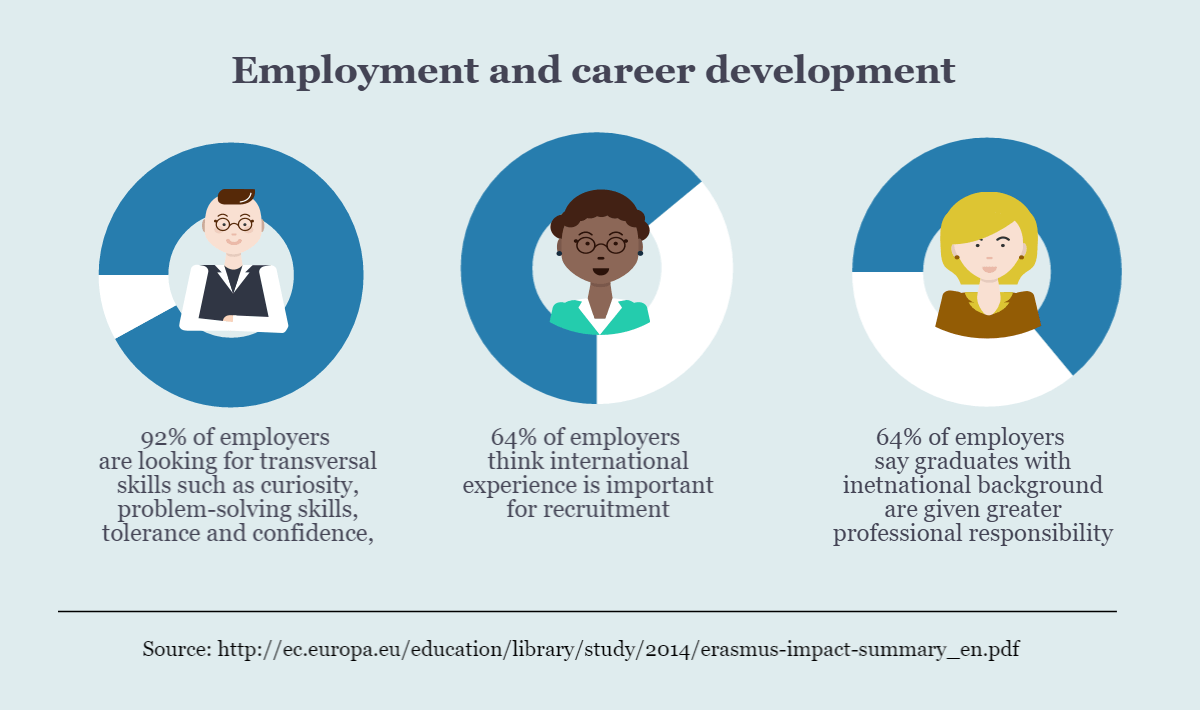
Young people who study abroad are half as likely to face long-term unemployment as those who do not study abroad. The unemployment rate of Erasmus students five years after graduation is 23% lower.
More than 1 in 3 Erasmus students who completed a job placement abroad were hired or offered a position by their host company.
64% of surveyed employers said that graduates with an international background are more often given greater professional responsibility.
Global trends in international student mobility
The world is becoming increasingly globalized, and international experience is one of the most essential components of higher education in the 21 st century. Just take a look at these facts:
The global number of students who study abroad continues to rise with an annual increase of 10%. There were almost 5 million international students in 2014. The Organization for Economic Co-operation and Development (OECD) has projected that, with demographic changes, the international student population is likely to reach 8 million by 2025.
The United States, the United Kingdom, Germany, France, and Australia are the most popular host countries for international students. Half of all international students study in these five countries.
Regions that hosted the largest number of mobile students in 2013 were North America and Western Europe (57% of total mobile students), East Asia and the Pacific (19%), and Eastern Europe (10%).
The countries with the most students studying abroad are China and India. According to UNESCO, there were 712,157 Chinese students studying abroad in 2013. Several small countries including Andorra, Anguilla, Bermuda, Liechtenstein, Luxembourg, Montserrat, the Seychelles, and the Turks and Caicos Islands have more students studying abroad than at home.
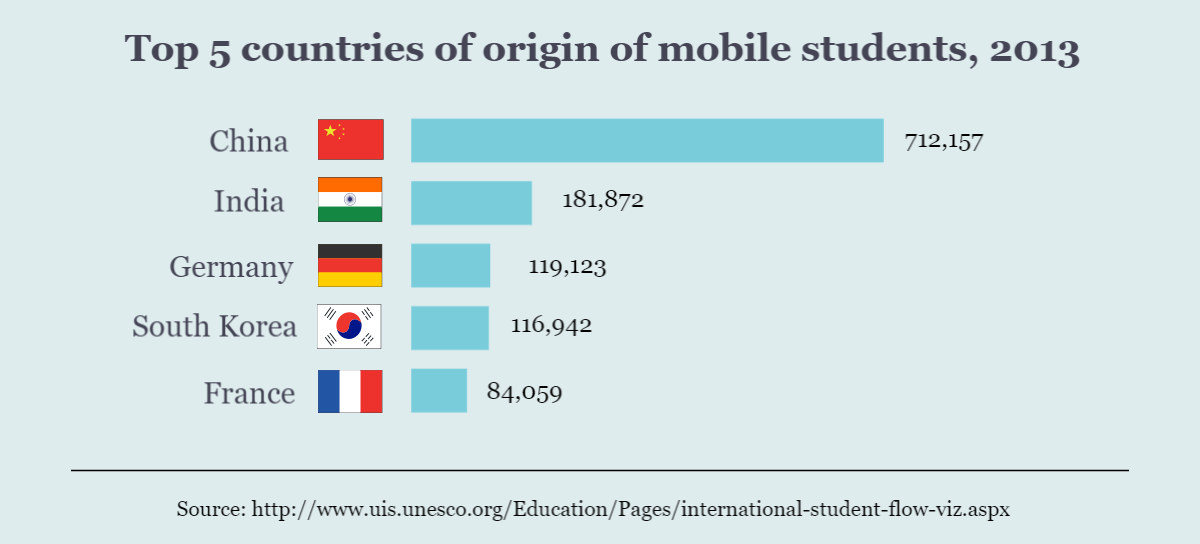
International students who study social sciences, business and law primarily go to English-speaking countries to study (more than 30% of the total number). Australia, the United Kingdom and the United States together host 36% of all foreign students worldwide.
New players have emerged on the international education market in the past few years, such as Canada (5% of foreign students), Japan (4%), Russia (4%), and Spain (2%). At the same time, the market share of the most popular countries is declining: the share of international students in the United States decreased from 23% to 17 % between 2000 and 2011.
Several traditional source countries are working hard to increase their attractiveness to international students. China hosted nearly 380,000 foreign students in 2014 but has a target to attract 500,000 students by 2020; Japan is aiming for a target of 300,000 international students in 2020; and Malaysia wants to attract 250,000 foreign students by 2025.
International students in the USA
A lot of foreign students choose the United States as their study abroad destination. Here are some specific figures about international students in the USA:
There were nearly 1.2 million international students with F (academic) or M (vocational) status in the United States, according to the latest quarterly report on international student trends released by the Student and Exchange Visitor Program (SEVP). According to data from a March 2016 SEVIS report, the number of international students at U.S. schools increased 6.2% compared to March 2015.
40% of international students in the USA study science, technology, engineering, or mathematics (STEM).
New York University (13,851), the University of Southern California (13,080), Northeastern University (11,381), Columbia University (10,810) and the University of Illinois (10,690) have the highest number of international students. More than 10,000 foreign students were enrolled at each school in March 2016.
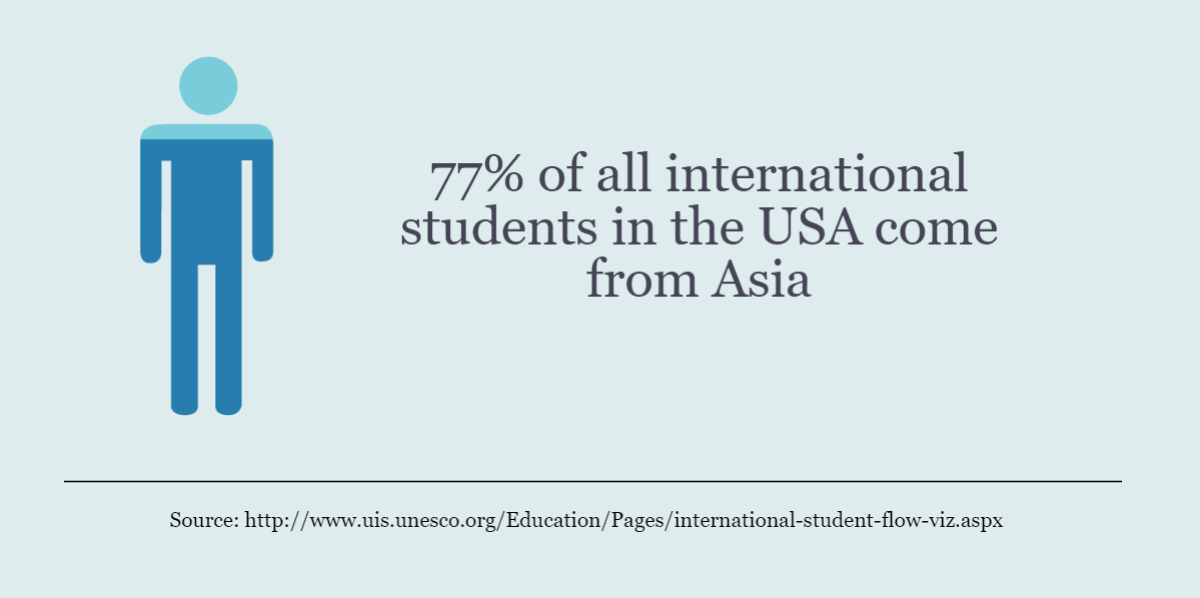
The top 10 countries where international students come from include China, India, South Korea, Saudi Arabia, Canada, Vietnam, Japan, Taiwan, Brazil, and Mexico.
Many countries support the idea of studying abroad. For example, Japanese university Sojo aims to make 50% of their students participate in study abroad programs.
NAFSA’s latest analysis finds that the 974,926 international students studying at U.S. colleges and universities contributed $30 billion to the U.S. economy and supported more than 373,000 jobs during the 2014-2015 academic year.
In their study increasing international study abroad rates for business students, Gordon and others emphasized six major barriers—money, relatives, friends, career relevance, knowledge availability, and university participation.
Many international students aren’t informed on health insurance in the country they’re visiting. Only 14% of students confirmed the collaboration between their college/university and health organizations.
U.S. students studying abroad
American college students are not as globally minded as theirs peer from other countries.
But the situation is improving, and the number of U.S. students going abroad keeps increasing every year, a growth pattern that is likely to continue. If you’re willing to find out more, what a better way to learn about the topic than from the students themselves in a form of free college essays examples?
The number of U.S. students studying abroad for credit in the 2013-2014 academic year grew 5.2% from 289,408 students to 304,467 students.
The most popular destinations for U.S. students studying abroad in the 2014-2015 academic year were the United Kingdom (38,250 U.S. students), Italy (31,166), Spain (26,949), France (17,597), China (13,763), Germany (10,377), Ireland (8,823), Australia (8,369), Japan (5,978), and South Africa (4,968).
63% of U.S. college freshmen aim to study abroad. However, only 14.3% graduate from foreign colleges.
40% of U.S. students attend studies in only five countries in Europe (UK, Germany, Italy, Spain, France) where they study to become qualified specialists, whether they return to the U.S. or stay in Europe.
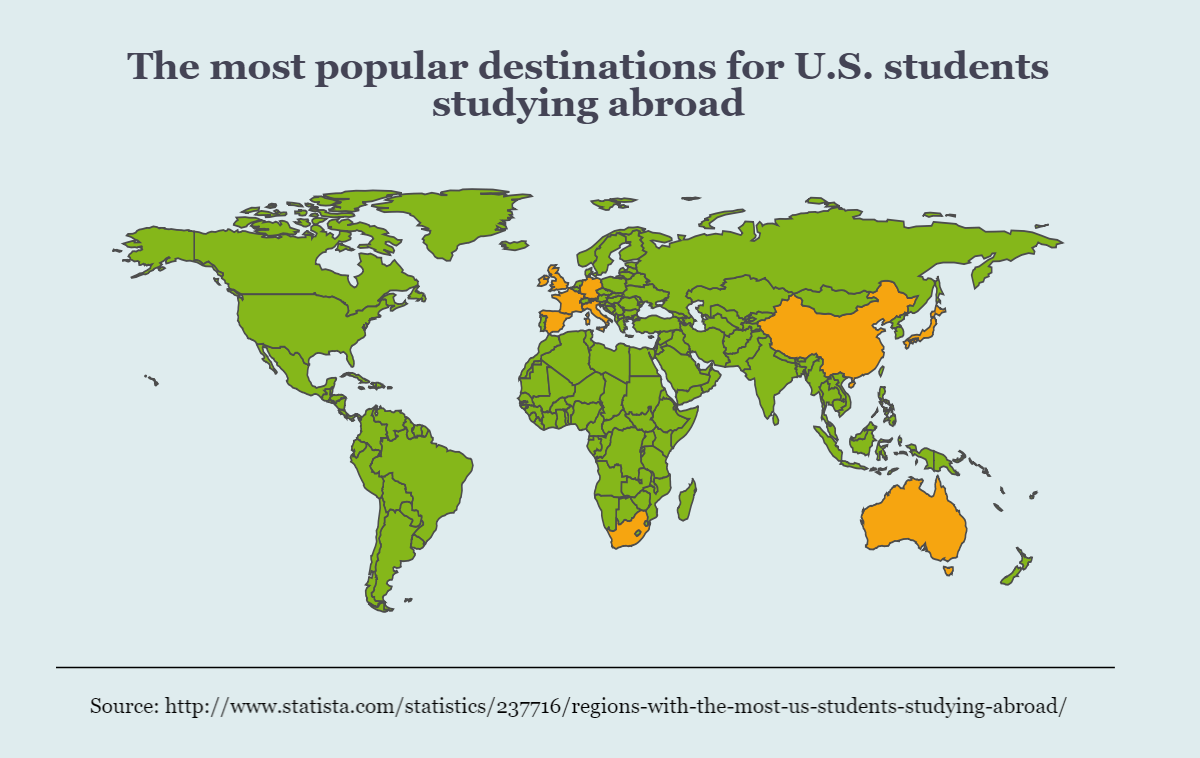
Europe is the most popular region for U.S. students studying abroad. There were 162,282 American students studying in Europe in the 2014-2015 academic year. Latin America and the Caribbean hosted 49,312 students from the United States, while Asia hosted 36,290.
Study abroad ranking site Abroad101 notes the following up and coming countries Ghana, Cuba, Tanzania, Turkey, Morocco, Switzerland, Russia, Romania, Jordan, and the UAE.
68,798 American students were studying science, technology, engineering, or mathematics (STEM) in different countries around the world in the 2013-2014 academic year. Another 59,687 American students were studying business, while 57,067 studied foreign languages and international studies.
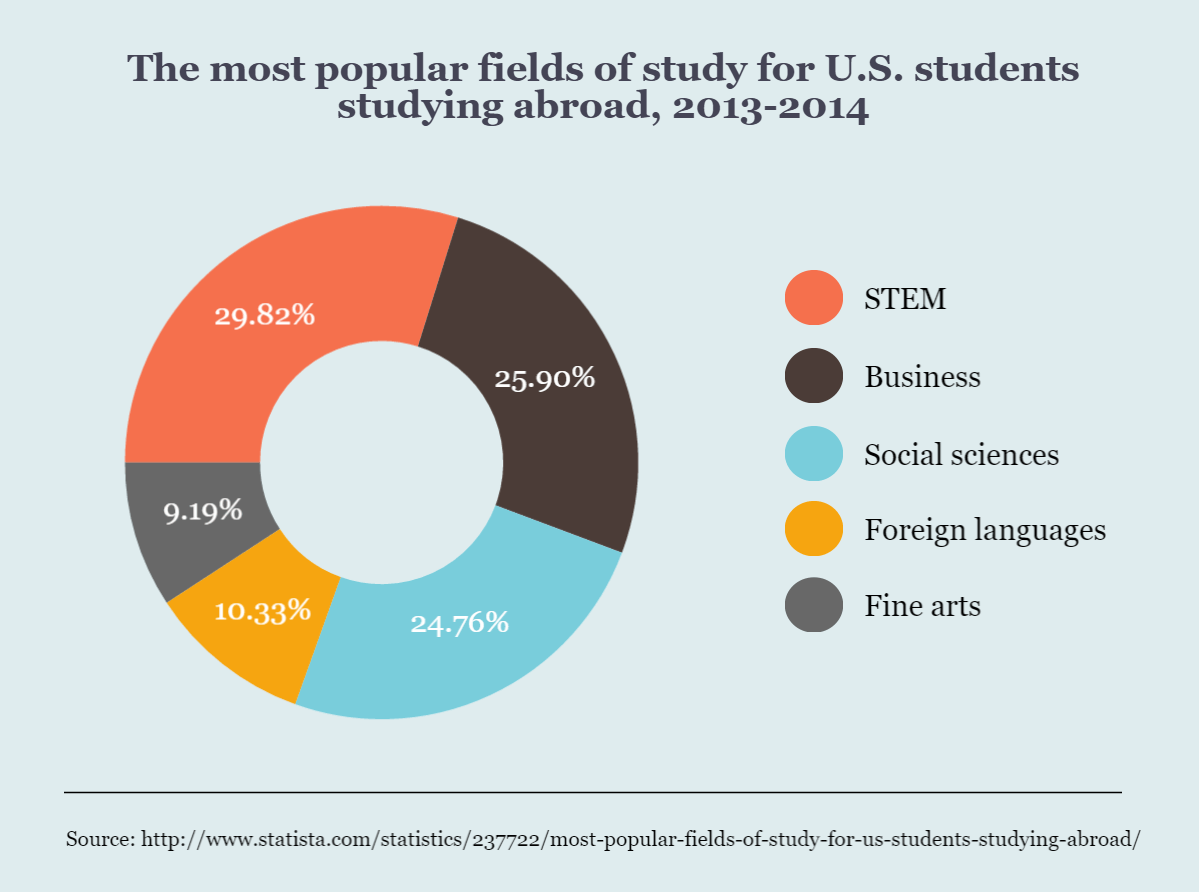
The majority of U.S. students (62%) studied abroad for just 8 weeks or less. 35% of the students stayed for one semester, and only 3% of American students stayed long term for a year.
3,638 disabled students studied abroad in the 2013-2014 academic year, according to the U.S. Department of State-sponsored Open Door Report on International Educational Exchange.
100% of first-year Harvard Business School students are required to complete an international field project with a partner company in an emerging market country.
In 2017, 43% of 8,000 U.S. parents interviewed said they would think about sending their children to a foreign college. That’s 15% higher than the previous year.
65% of American college students who study abroad are women. Only 5% of Americans who study abroad are black, according to the Institute of International Education.
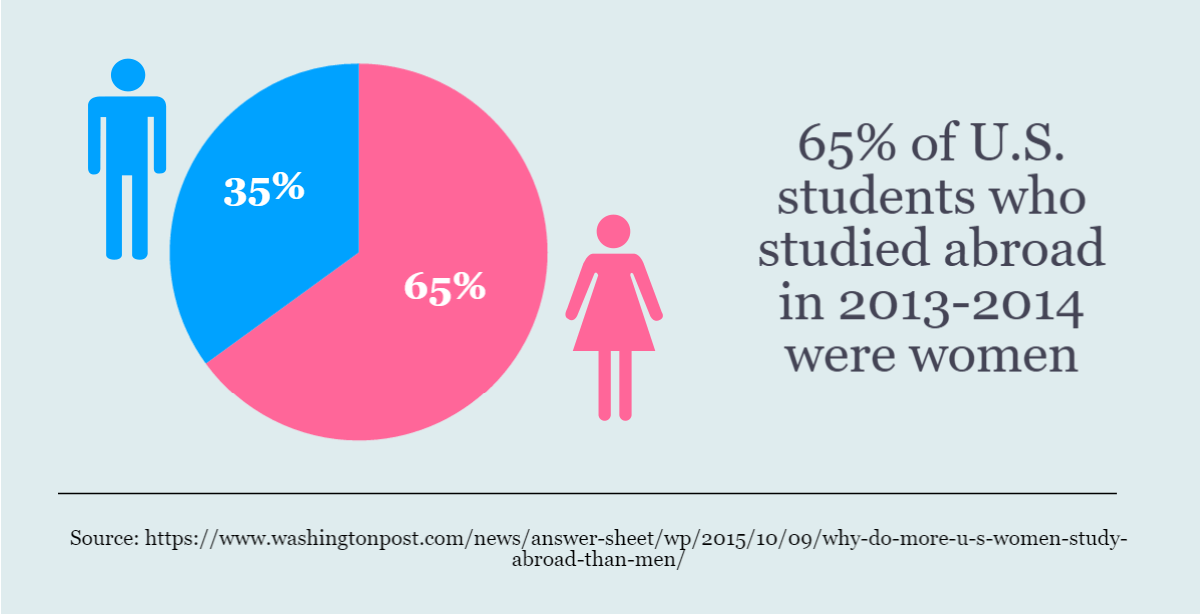
The Institute of International Education has launched a new five-year program called “Generation Study abroad” to double the number of U.S. students studying abroad from the present number of 295,000 (10% of all American students) to 600,000 by 2019.
Contrary to popular belief, showing cultural films in class doesn’t provide a sharp increase in students’ motivation to go abroad. In the study, during Indian movie classes, only 31% of students were motivated to study abroad.
Since the time of this article’s publication, Mark Shay from Abroad101 shared an interesting observation with us. The SEVIS report mentions the number of foreign students present in the country in any given year, meaning that these numbers include full degree students, as well as exchange students. When it comes to American students, however, the focus usually lies on exchange, rather than full degree, students. There is thus some discrepancy as to how the numbers are reported when it comes to international students in the U.S. and U.S. students abroad.
Why is study abroad essential?
We live in an increasingly globalized world. New technologies have led to the international integration of national markets and businesses. To successfully compete in the global marketplace, multinational and small businesses need employees with cross-cultural competence and knowledge of foreign languages.
More than 100 Chinese companies were included on the 2016 Fortune Global 500 list, which ranks the world’s largest companies based on revenue. In fact, China takes three of the top five places on the list.
Research from the McKinsey Global Institute shows that by 2025, 45% of the world’s largest companies will probably be based in emerging markets.
A recent survey found that almost 40% of U.S. companies missed international business opportunities due to a lack of internationally competent personnel.
International trade creates and supports jobs in the United States. More than one in five American jobs are tied to international trade (38 million jobs in 2013).
According to research conducted by Professor James Foreman-Peck for the Department of Business, Innovation, and Skills (BIS), deficient language skills as well as the assumption that “everyone speaks English” are costing the UK economy about 3.5% of its GDP.
A British Chamber of Commerce survey (2013) reveals that 62% of non-exporting British companies regarded languages as a barrier to looking for international opportunities, and 70% of exporters had no foreign-language ability in countries where they operate.
70% of UK businesses value foreign language skills in their employees, and 38% of businesses consider language skills particularly helpful in building relationships with clients, customers, and suppliers.
Language barriers increase the difficulty and cost of doing business on the international market. According to a report by the University of Wales, 25% of export companies in England and Wales had lost businesses because of language and cultural deficiencies.
It is clear that employers are seeking candidates with study abroad experiences on their resumes. Students who want to work in our deeply interconnected world must study abroad.
There is no doubt that studying abroad will change your life. It offers you a chance to experience other cultures, make international friends, learn new languages, improve your job prospects, contribute to your personal development…and maybe even find the partner of your dreams!
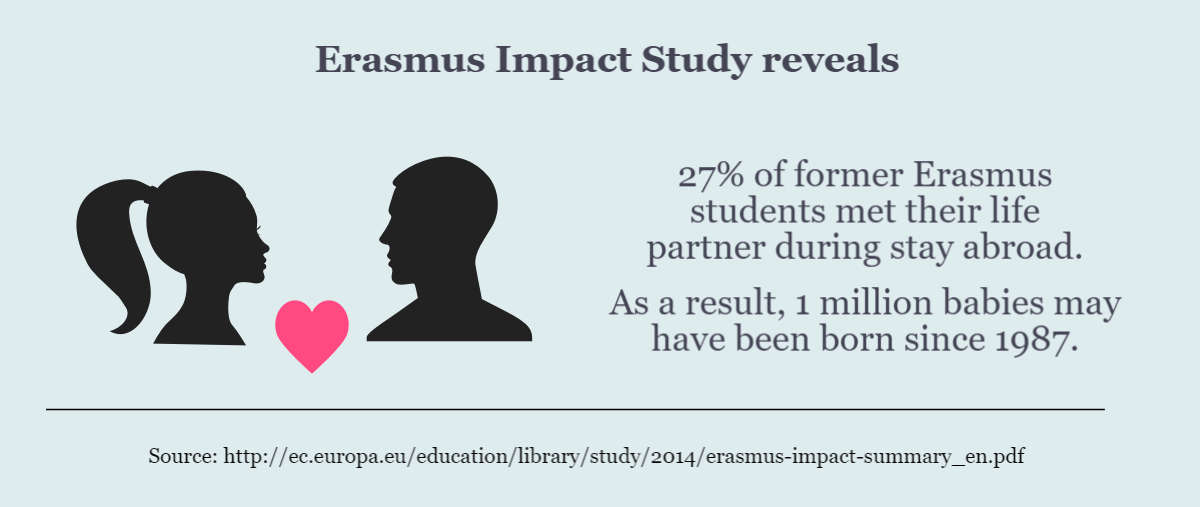
We hope that these study abroad statistics that reflect modern realities have helped you get a clearer picture of this unique, life-changing experience and understand the benefits of studying abroad. Of course, study abroad is a serious undertaking. It will challenge you on a personal level. It will have an impact on your college career. And it costs money. But it is also an investment in your future, both academically and professionally, because the study abroad experience is now more valuable than ever.
Need a guide on how to become an international student? Check out IvyPanda’s guides and infographics.
For example, you may want to know what mistakes to avoid in a foreign country (especially when you’re an international student).
Quantifying Travel: How Many People Travel a Year?
Home » Travel Industry » Quantifying Travel: How Many People Travel a Year?

Travelling is fun. Humans have been travelling ever since the dawn of civilization. These days, with so many vibrant cultures, gorgeous sights, and excellent food available worldwide, people can’t seem to get enough of travelling.
Travelling itself has also become far, far cheaper than it used to be. While in the past, it took thousands of dollars to fly over the Atlantic, now it only takes a couple of hundred with a budget airline option – but that begs the question:
“How many people travel a year?”
Far less than they used to, at least in 2020. The coronavirus pandemic has us all a bit worried. Due to the lockdown, travel restrictions, and financial crunch most of us face – it’s fair to assume that travelling to exciting holiday destinations isn’t our top priority.
Nevertheless, in this article, we’ll cover some of the most interesting recent millennial travel statistics as well as general ones and comparing them to the past years.
How Many People Traveled Internationally in 2019?
The year 2019 was perfect for the global travel industry. More people travelled than ever, and the total contribution to the global GDP from travelling has increased. People have also started seeking out alternative destinations that weren’t nearly as popular in the past.
As of 2019, the global travelling industry has experienced a very positive year with over $9,258 trillion in total travel and tourism contributions to the global GDP – a $3,454 trillion increase in just a decade.
While it’s hard to measure just how many people travelled in 2019, a rough estimate would be about 1.46 billion, which means that every fifth person in the world travelled in 2019.
The most popular destination for travelling in 2019 was Tokyo, Japan. Japan is continually topping the charts as a popular destination for casual, holiday, and business travelling – primarily due to the annual Golden Week festival.
Some other popular destinations for travelling in 2019 were Serbia, Australia, China, and Spain.
The most popular region to visit was North Asia, with a total contribution of $2.1 to the global GDP, which is only $0.1 trillion more than Europe, contributing to the worldwide GDP in the same timeframe.
How Many People Traveled Internationally in 2020?
With the advent of the coronavirus, the travelling industry took a sharp hit in 2020. The numbers are down, most likely due to the many travel restrictions imposed to cut down on the coronavirus’s spread – but the overall growth is still positive. Many people haven’t travelled as much because many of them lost their jobs and are tighter on funds than they used to be.
Nevertheless, 2020 wasn’t a complete bust when it comes to travelling. The global contribution the travel industry has had on the global GDP is $10,001 trillion.
The most popular place to visit in 2020 has been Macau, the world’s renowned gambling capital located in the Special Administrative Region of the People’s Republic of China.
Despite the coronavirus pandemic, the global travel industry has surprisingly exceeded many expectations that people had for 2020.
The most famous hotel chain in 2020 has been Hilton Hotels & Resorts, with a whopping $10.83 billion in brand value. Due to the many travel restrictions, particular places such as Australia, India, and Japan have seen a decrease in visitation over 2020.
According to a report, though, in the first half of 2020, international tourist travels went down by 65%. This roughly translates to 440 million international arrivals less than the year before. And, according to another report, it is estimated that the number of international tourist travels can go down by as much as 80% by the end of 2020.
The actual numbers will show the reality, but it is too early to know for certain. This poses a ton of problems – mainly impacting people who are employed in this sector.
But, as borders are opening up, it is expected that the numbers will go back up. However, we can safely say that these numbers were expected due to several travel restrictions caused by COVID-19.
Historical Comparison With the Previous Years
The world of travelling has grown exponentially in the 21st century, and each passing year seems to be bigger than the last. Booking numbers are up, travel is getting less expensive, and more destinations are becoming that much more appealing.
While the growth might be exponential, slow and steady wins the race. For example, the world travel contributions to the global GDP don’t always increase year after year, as 2015 was less profitable than 2014.
The most consistent travel destinations by their popularity in the past decade have been the UAE, Macao, Japan, China, and Mexico.
Continent-wise, the situation hasn’t changed much. Europe and Asia are still pretty tied as the most popular destination for visits, while Oceania and Africa are at the bottom. The Middle East and Northern Asia have met the most significant rise in popularity.
Recent Travel Trends
The habits of travellers have changed quite considerably, especially due to the coronavirus pandemic. Some of the most significant changes that consumers have demanded from the travelling industry are:
- Integration of IoT Technology
- Improved cleanliness and sanitation
- Easier booking
- More affordable flights
- Green hotels
- Wellness vacations
People are also favouring exploring holiday destinations on their own as opposed to a tour-guided vacation. More and more people seek out holidays and country-specific events rather than regular vacations in those countries, which becomes apparent with Japan’s Golden Week.
Customers are also looking to cut down on their carbon footprint as much as possible, which is why green hotels are far more popular.
Travellers are increasingly seeking travel insurance, as safety is becoming a more prominent consumer demand. This is also why travellers are seeking IATA-certified agencies at a significantly increased rate.
The Bottom Line
Travelling is one of the most fundamental needs that human beings have hardwired into their hearts and minds. Exploring new places, cultures, and cuisine is just as important as meeting new people, acquainting yourself with new things, and enriching your experiences.
The world of travelling is only growing, as travelling itself is becoming better, simpler, and more affordable – not to mention that the amount of options is continually growing. While the pandemic might have most of us locked up in our homes, we’re sure that once SARS-COV-2 subsides, travel will pick right back up where it started.

Senior Director of Business Development APAC at Hotelmize, fourteen years experience in the travel industry in the APAC region, including eight years expertise in the travel technology industry, with a track record of proven success in the sales of travel technology solutions.
Hotelmize is an AI-driven Travel-tech startup company that allows travel companies to increase their hotel bookings’ profits by more than 35%, optimizing their purchasing rates post-booking in a fully automated procedure.Hotelmize monitors and processes millions of bookings and billions of US$ value each year.
SHARE THIS STORY


Related Posts

Have you ever heard the term Fully Independent Traveler (FIT)?

What is Educational Tourism: Stats, Benefits, Examples & More

What Does Social Tourism Mean and How it is Redefining Travel?
Join the travel tech club!
We’ll be sending you curated materials handpicked to help you learn more about interesting topics on travel and technology.
Source https://ec.europa.eu/info/strategy/priorities-2019-2024/promoting-our-european-way-life/statistics-migration-europe_en
Source https://ivypanda.com/blog/46-study-abroad-statistics-convincing-facts-and-figures/
Source https://www.hotelmize.com/blog/quantifying-travel-how-many-people-travel-a-year/